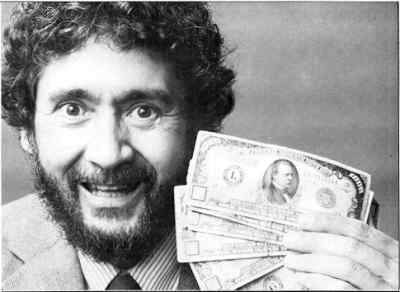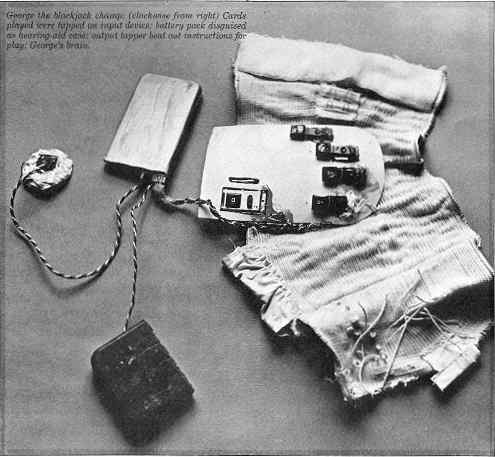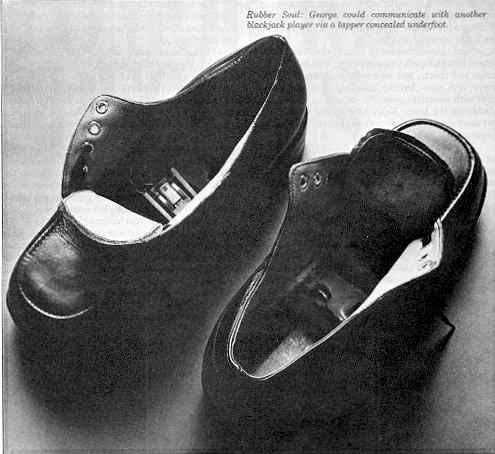
CASING THE
CASINOS
by Ken Uston
Ken Uston is author of the 60 Minute Guide to computers series and the best-selling How to Beat PacMan. He is a world-renowned blackjack player, having successfully assured through a court case the right of "card counters" to play in Atlantic City casinos.
Gamblers have a natural affinity for computers, and with good reason. Computers create order out of the seeming randomness of the universe. In fact, computers led to the knowledge that the game of blackjack could be beaten.
In the late 1950s a group of scientists analyzed the rules of blackjack as established by the Nevada casinos. Through computer algorithms, they uncovered the astounding fact that blackjack, unlike craps, roulette or slot machines, could be mastered if the proper mathematical principles were applied. This was due to the finding that the odds change back and forth between the player and the house in relation to changes in the content of the deck(s).
To take the simplest example: when a player is dealt a "blackjack" (the combination of an ace and a ten or picture card), he wins one and a half times the amount of his bet. If the dealer gets blackjack, the player loses the amount of his bet. Thus the more blackjacks, the better for the player.
If the first round of a single-deck game is dealt out and all four aces appear, the chances of a blackjack on the next hand are zero. The odds for the player entering the second hand are much lower than normal. Conversely, if no aces and few tens and picture cards appear during the first round, the chances of blackjack(s) occurring during the second round are statistically better than usual. When the player has the advantage, he can bet large amounts; when the odds favor the house, the player can bet small. The weighted average of these bets yields the player an edge over the house. (Before you run out and bet your last dollar, bear in mind that this is a grossly oversimplified illustration.)
Others improved upon this pioneering work, and the early 1970s saw the emergence of a new, rare breed of entrepreneur: the professional blackjack player. It took card sense and a good memory to keep track of the hands as they were played, but various "card-counting" systems began to yield impressive results.
I started playing blackjack in 1973, when I was senior vice-president of the Pacific Stock Exchange. The corporate hierarchy got to me, and soon the cash generated from occasional forays in Nevada far exceeded my monthly paycheck. Before long I was playing blackjack full time. Then one day, after several years of successful play in Nevada, Europe and the Orient, I received an unusual phone call from a scientist in California. His name was Keith Taft, and he told me he'd developed a computer that played perfect blackjack and could be worn inside a casino without detection. It wasn't cheating, mind you-merely an aid in assessing the odds. But in casinos where even pocket calculators are frowned upon except during computer conventions, it was best to be discreet. I asked Keith to catch the next plane to Vegas.

George the blackjack champ. (clockwise from right) Cards played were
tapped on input device; battery pack disguised as hearing-aid case;
output tapper beat out instructions for play; George's brain.
When I saw the computer, I knew Keith was on to something but I also felt the design was impractical. We worked together and finally came up with a device, code-named George, that appeared to meet our needs. George's brains consisted of a microprocessor, memory and a stored program crammed into a plastic box the size of an eyeglass case. After calculating the advantage enjoyed by either the house or the player on the next hand, George would calculate how much the player should bet to the nearest $10. George also kept track of all cards played and told the player precisely what to do with his hand (whether to hit, stand, double down or split pairs).
A pocket-size input device, with four switches activated by each of four fingers, gave George information on game play. The switches worked on a binary code, with values from 1 through 15 to indicate cards played. George's output device was a little tapper that vibrated, using a series of Morse-like dots and dashes, encoded to tell the player how much to bet and how to play his hand. A separate battery pack powered the entire system. George's components were wired together and scattered among various more or less intimate parts of the player's body.
On February 1, 1977, George and I took a cab to the tiny Golden Gate casino in downtown Vegas. To my knowledge, this was the first time a viable blackjack computer had been used in a casino (there had been several attempts, e.g., bulky models under raincoats, eyeglasses with flashing lights). I played for several hours, betting only $5 to $50 and coming out a few hundred dollars ahead. The statistics were meaningless, given the small sample size of two hundred hands or so, but in the process we had proved that George would work.

Rubber Soul: George could communicate with another blackjack player
via a tapper concealed underfoot.
Now we began training "computer operators"-people who pushed the buttons as they kept up with the cards that were dealt. To prevent detection from the pit bosses, Keith devised a unit that made it possible for a computer operator to send signals via a small radio transmitter to another player: the Big Player, or BP. All the BP had to do was just stand at the blackjack table, betting and playing his hand according to the signals he received from a "tapper" hidden in the instep of his shoe.
Next, condominiums in Las Vegas were transformed into blackjack training rooms, with flash cards, tables and charts, and electronic workshops. Everywhere were wires, battery chargers and "magic" shoes filled with electronic gear. My job was to recruit and administer the team. Keith handled the electronics. Our team soon grew to sixteen people: eight computer operators and eight BPs.
Then one Monday morning at 2 A.M. I took $50,000 out of my safety-deposit box and we set out for the casinos. We had decided to play the "graveyard" shift since there would be far fewer players at the tables, allowing us to play more hands per hour and thus earn at a higher rate.
That night we won over $20,000. Over the next three weeks we won about 80 percent of the time, which was far better than our average of 60 percent playing "manual" blackjack. After five weeks our team was up $110,000. I particularly remember one of our younger members who earned $2,100 during that time. He looked at the twenty-one $100 bills we gave him as if he couldn't believe they were really his.
At first the casinos loved our BPs, whom they viewed as high-rolling suckers bound to lose a bundle. One time our BPs were simultaneously "comped" (given free services) at the MGM, Caesars Palace, the Stardust and the Sahara. Of course, our BPs were living quite well, in lavish suites, often with grand pianos, and enjoying ringside show tickets and gourmet meals "on the house."
We kept winning and eventually we started getting "heat" from the pit bosses. Agents would follow our BPs out of casinos, and we had to resort to having our people take several cabs, a la Mission Impossible, before they returned to my condominium. It was when we decided not to tempt fate, to leave Vegas, and set up shop in Lake Tahoe, that we made our fatal mistake.
I rented a house high in the hills of Tahoe, where we set up our electronics workshop on a ping-pong table in the attic and trained before we went to play on a sunny day early in May 1977. I dispatched four teams of two people each: two to the huge Sahara casino, one to Harrah's, and one to Harvey's Wagon Wheel. The BPs bet up to $1,000 per hand, and that day we won $25,000.
The next day, May 14, 1977, four hours after the teams had left for the casinos, the phone rang. As I picked it up, I was fully prepared to hear that we'd won $30,000 or so.
"Ken, this is Steve."
"Hi. How're things going?"
"I'm in jail."
He'd been operating his computer in Harrah's and was suddenly jostled into a back office by two burly security guards. They stripped him and found him full of wires and electronic devices, no doubt thinking he was some kind of terrorist. Apparently they called the other casinos, because two other teammates were arrested. The police must have had some difficulty coming up with an applicable violation. The charge was "bunko steering"-luring an unsuspecting individual into an illicit gambling game. At any rate, I posted the $6,000 bail and we left Lake Tahoe.
In retrospect it was obvious that placing $1,000 bets at the Lake drew far more attention than it did in Vegas. Even a $100 bet at the Lake attracts attention from the pit. The Casino Control Commission was totally baffled. They didn't know what to make of our equipment (to this day, it's not illegal to use computers in a casino-a loophole that no doubt will someday be closed) and ended up shipping the computers to the FBI in Washington for analysis. Five months later the FBI sent them back, saying that in their opinion the computers were not "cheating devices." All charges were dropped.
No, we didn't try to resume later, largely because one of the people arrested was Keith's son. Keith had been getting a lot of pressure from his wife to get out of blackjack-to do something "legitimate"-and he decided to quit. I didn't pursue the issue, since I had returned to the world of cerebral blackjack.
Yes, sometimes I feel as if I blew it. If I'd been content to have our team generate $10,000 or $20,000 per week, chances are we'd still be playing. On the other hand, it's always been my philosophy in playing blackjack that if there's an opportunity, you should capitalize on it immediately and to the fullest. Otherwise, it will either evaporate or someone else will take advantage of it.
No, I don't look back. There are too many things going on now. Still, when you consider where electronics technology has gone, you can't help but think of doing it again-only in a much more refined way. I can't promise that I won't someday.
Return to Table of Contents | Previous Article | Next Article

